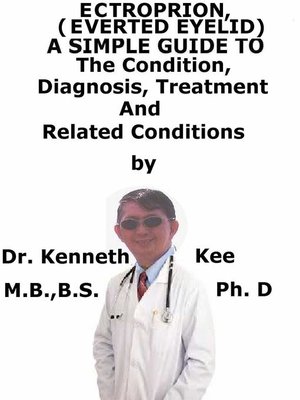Ectropion, (Everted Eyelid) a Simple Guide to the Condition, Diagnosis, Treatment and Related Conditions
ebook
By Kenneth Kee

Sign up to save your library
With an OverDrive account, you can save your favorite libraries for at-a-glance information about availability. Find out more about OverDrive accounts.
Find this title in Libby, the library reading app by OverDrive.



Search for a digital library with this title
Title found at these libraries:
| Library Name | Distance |
|---|---|
| Loading... |
This book describes Ectropion (Everted Eyelid), Diagnosis and Treatment and Related Diseases
Ectropion is not as common as Entropion.
Senile ectropion is often bilateral and results from a natural loss of muscle tone and orbital fat.
Ectropion is a medical disorder when the lower eyelid turns or sags down and outward, away from the eye, exposing the inner surface of the lower eyelid.
Ectropion is categorized into these categories on the basis of cause:
1. Congenital ectropion
This is due to a developmental vertical foreshortening of anterior lamellar tissue, causing eversion of the lid margin
2. Cicatricial ectropion
This happens from vertical foreshortening induced by the acquired scarring or inflammation and may happen together with involutional horizontal lengthening of the lid margin caused by chronic vertical traction.
The treatment in these cases is aimed at lengthening the lid vertically with mid-face lifting or skin grafts or flaps.
Concomitant repair of any horizontal component is the same as repair of involutional ectropion
3. Mechanical ectropion
This is due to a mass effect on the eyelid (e.g., from a tumor), which draws the lid margin away from the globe
It is treated through treatment of the underlying causative factor (e.g., tumor excision)
4. Involutional ectropion
This is caused by horizontal laxity of the eyelid, making stretching of the lid or dehiscence of its attachments at the medial or lateral canthus, with resultant out-turning of the lid margin
Of these, involutional ectropion is the type most often observed in medical practice.
Causes
The main cause of ectropion is muscle weakness or tissue relaxation that happens as part of the normal aging process.
Ectropion may be due to several factors such as facial paralysis and injury.
The most frequent cause is muscle weakness or slipping due to aging.
The risk of developing ectropion rises with age.
Other risk factors are:
1. Stroke
2. Skin cancer
3. Injury
4. Scar tissue from injuries or burns
5. Growths on the eyelid (either cancerous or benign)
6. Birth defects (due to genetic disorders such as Down syndrome)
7. Bell's palsy — which injures the nerve that controls facial muscles or other types of facial paralysis
8. Previous surgery or radiation treatment of the eyelids
9. Rapid and significant weight loss
Symptoms
Ectropion (out-turning of the eyelid) can manifest with keratoconjunctivopathy, infection, and dermatitis, among other signs and symptoms.
Tearing is a frequent manifestation when the punctum is everted (causing a tear outflow problem) or not (as in reflex tearing from irritation and exposure keratoconjunctivopathy).
Combined-mechanism tearing is not abnormal in these patients.
This disorder can produce eye dryness, excessive tearing, and irritation.
When a person blinks, the eyelids help dispense tears that protect and lubricate the eyes.
The tears pass into the puncta, which are openings inside the eyelids that go to the tear ducts.
When the lower lid turns outward, it influences the way tears drain.
This draining of the tears can produce a range of symptoms such as:
1. Excessive tearing
2. Excessive dryness
3. Irritation
4. Burning
5. Redness
6. Chronic conjunctivitis (inflammation also known as "red eye")
If a person has symptoms of ectropion, a person requires prompt medical treatment.
Artificial tears and eye ointments can help lubricate the cornea and prevent vision-threatening injury.
Frequent wiping of...







